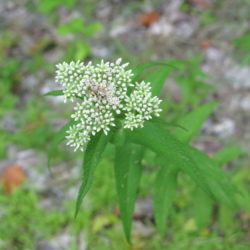Etymology
Eupatorium is Latin for Mithridates Eupator (134 – 63 BC), king of Pontus, who first recorded medicinal uses; perfoliatum is Latin for the appearance of perforation of the leaves by the stem.
Native Habitat
Damp fields, stream edges and bogs.
Garden Uses
Late-season blooms for beauty and pollinators; any moist garden, depression or stream edge.
Overview
Showy perennial with fuzzy clusters of tiny, white flowers atop 3 - 6 foot erect, fibrous, non-branching stems. Found in damp fields, stream edges, and bogs, as it prefers moist soil and sun, although it tolerates part-sun and light shade.
Leaves and Stems
Paired, simple, deep green, stalkless leaves, up to 8 inches long, unite basally to surround—or appear to be perforated by—the stem. Leaves are very finely toothed, and triangular to long and tapering. Stems are deep green, fibrous and hairy.
Flowers
White, fuzzy, flat-topped flower clusters each contain 9 to 23 disc florets, which lack petals.
Fruit/Seed
Fruit is tufted or bristled for wind-powered seed-dispersal.
Wildlife Associates
A variety of insects, birds and butterflies are attracted to the nectar and seeds of this plant. Generally it is not attractive to mammals, but it is occasionally browsed.
Propagation
Sow seeds thickly in the autumn, as germination rate is low. Divide clumps in spring or autumn.
Ethnobotanical Uses
Historically was included in bandages around splints to aid healing in cases of fracture, an idea possibly related to the fused leaves. Also used in a wide variety of tinctures and tonics, including for colds, fever and constipation.
Garden Location
South Woods (see garden map)
Sources
Lady Bird Johnson Wildflower Center
Plant Profile by Kate O’Dell

